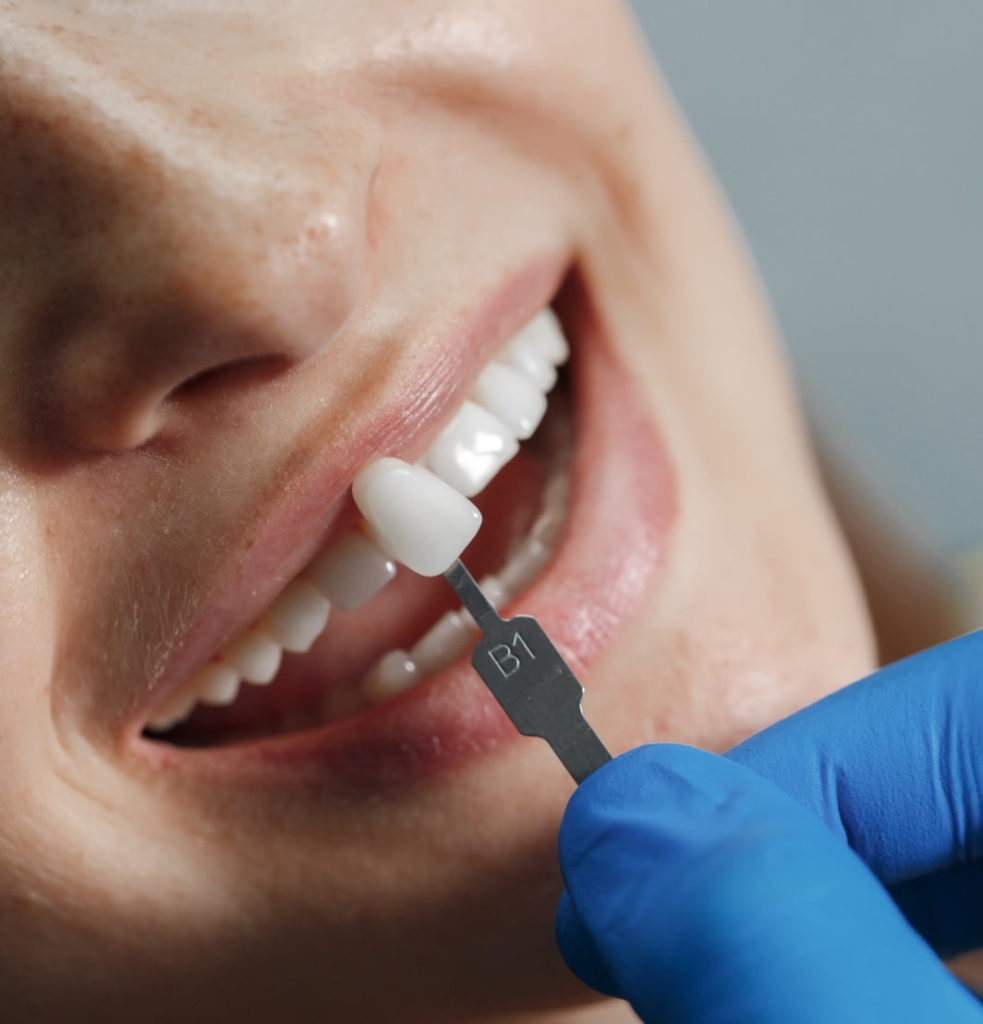Dental veneers, discreet aesthetics
Dreaming of a more harmonious smile? With dental veneers, Smile Clinique offers you a solution with immediate, painless results.
Dental veneers are ultra-thin ceramic prostheses that attach to the front surface of healthy teeth to enhance their appearance. Designed to blend seamlessly into your smile, these discreet prostheses improve the overall aesthetics of your smile. The number of veneers needed to achieve a perfect smile will depend on your smile.

There are two types of dental veneers: traditional veneers and pellicular veneers.
- Traditional veneers have a minimum thickness of 0.5 mm. They require slight tooth preparation to optimize adhesion.
- Pellicular veneers, with a thickness of 0.2 mm, are thinner and require no modification of the natural tooth.
Veneers are robust prostheses that can withstand more than 20 years without discoloration or damage.
Veneers are a minimally invasive, long-lasting aesthetic treatment.
Dental veneers are a popular aesthetic treatment for many patients. The technique is considered a practical, economical and effective alternative to more invasive dental prostheses such as implants, crowns or composite restorations of damaged teeth.
Dental veneers, a versatile solution to transform your smile
Dental veneers are a common solution for improving the appearance of a variety of dental problems, and are ideal for those wishing to restore a harmonious smile. The concept can be used to correct the shade, size, shape or alignment of teeth, or to strengthen brittle teeth – but only on healthy teeth. Here are some examples of the types of correction for which the Smile Clinique is most often called upon by its patients:
- Fading enamel defects, such as stains caused by certain antibiotic drugs (e.g. tetracycline antibiotics),
- Correct gaps and overlaps between teeth. Dental veneers can correct malpositions that cannot be corrected by orthodontics,
- Improve the harmony of a smile in the case of missing teeth (agenesis),
- restore normal shape to teeth that are too small, too large, too short, too long or too flat.
It’s important to stress that veneers can only be applied to 100% healthy teeth. Before veneers are applied, a dentist must ensure that the teeth are in full health and that there are no contraindications to veneer application. Any cavities or other infections must be treated before treatment begins.
Dental veneers, from laboratory fabrication to placement on your teeth
The steps involved in applying dental veneers are as follows:
- Initial consultation with your dentist. At this initial appointment, you and your Smile Clinique dentist will discuss and identify the defects you wish to correct. During this first appointment, your dentist will make sure your teeth are healthy and work with you to develop a treatment plan based on your treatment goals. This is a crucial step, as it defines the treatment outcome based on the morphology of your smile and the characteristics of your teeth (shape, color and size).
- Tooth preparation. Before applying dental veneers, the dentist must prepare the patient’s teeth by cleaning and polishing them to facilitate adhesion of the veneers.
- Impression taking. The dentist then takes an impression of the patient’s teeth using a 3D scanner. This impression will be used to fabricate the customized veneers.
- Veneer fabrication. The impressions are sent to the dental laboratory, where a dental technician fabricates the veneers from the 3D scans of the patient’s teeth. From the wax model, the veneers are reproduced in ceramic, then stained to give a natural appearance.
- Try-in. Once the veneers have been fabricated, the dentist tries them on the patient’s teeth to check fit and appearance. If necessary, veneers can be adjusted to ensure a perfect fit.
- Fitting the veneers. Once the veneers have been adjusted, the dentist places them permanently on the patient’s teeth using a bonding composite. The composite is applied to the tooth surface, then the veneer is placed on top and hardened using a special light. This process is repeated for each veneer until all are in place.
- Polishing. Once all the veneers are in place, the dentist polishes them to remove any excess composite and give them a smooth, natural appearance.
Dental veneers generally take around 3 hours to fit, and are painless for the patient. After fitting, the patient can enjoy a perfect, natural smile for many years to come, with good dental hygiene and proper care.

Dental veneers, how to care for them?
Ceramic dental veneers are strong and stain-resistant, but to ensure their durability, it’s important to take good care of them.
In terms of use, there are no particular restrictions: you can eat anything normally, just like with natural teeth. However, it is advisable to avoid biting into very hard or sticky foods that could damage the veneers.
To care for your veneers, brush twice a day with a soft toothbrush and fluoride toothpaste. It’s important to adopt a gentle brushing technique to avoid damaging veneers or gums. Rinsing with clear water after every meal can also help prevent staining.
It’s also highly recommended to wear a mouth guard at night. Many people clench or grind their teeth at night without realizing it, which can damage veneers and natural teeth. The splint provides a protective barrier and helps extend the life of veneers.
